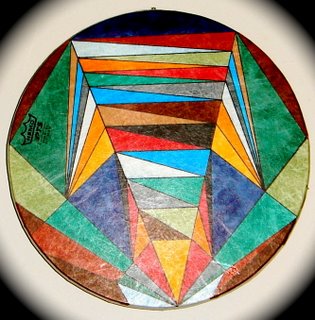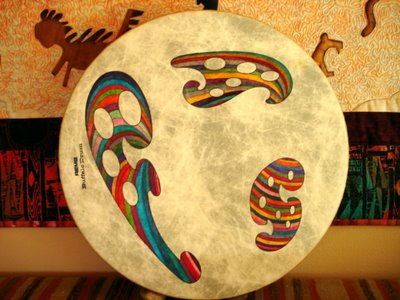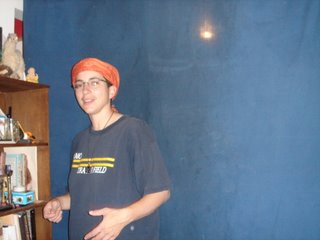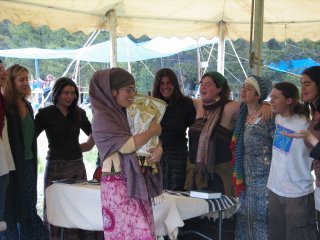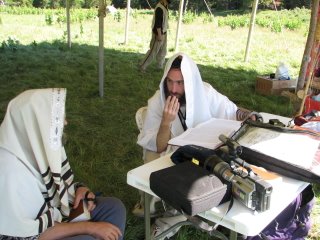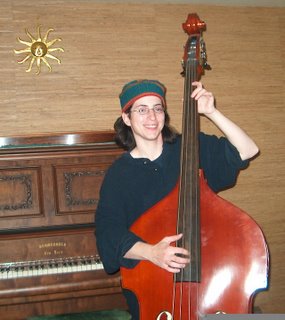B"H
A friend and mentor maggid asked me to write up my thoughts on requirements for training maggidim. As it is relevant to the conversation of just what a maggid is, and how maggidut differs from rabbinics, I'm posting it here. Some editing has been done to protect issues of confidentiality. All comments welcome!
--------------------------------------------------------------------------------------
B”H
(--------), shalom shalom.
In my reply to your email I suggested that the first place to start for maggidic requirements is the ability to define what a maggid is. I wasn’t being funny. This is so important, without it I think a maggid is really dead in the water (so to speak.) In this reemerging field of maggidut there is a wide range of opinion about what exactly is a maggid, with each teacher/ school claiming its own definition. Storyteller? Rabbinic Pastor? Facilitator of Sacred Autobiography? Outreach Worker? Melamed? Personally, I think they are all true, since maggidut, like rabbinics or hazzinut, is A PROCESS. This is a very important statement, so important I’m putting it right up here at the beginning. Maggidut is a process that constantly informs the way that a maggid operates in the field. Understanding this from the start is crucial, as it also informs the way that a maggid learns the tools of the trade. When I study rabbinics, I am doing so through the eyes and needs of the maggid. I am learning (and teaching) the material from a different perspective than I would if I was studying to be a rabbi or a hazan, or possibly even a rabbinic pastor in the sense that institutions like ALEPH define that role. (Keeping in mind that there is a tremendous amount of crossover between the roles of rabbi/ hazan/ maggid/ pastor… and that the best rabbis are also maggidim, eh?)

What does this mean? A maggid’s primary job is to “Relate” to the people. To Relate. Everything must come through this perspective. When I am learning new material, I am constantly thinking about how to apply it in the field. Maggidut is not about performing, as can be the case with cantorial soloists, and not about executing, the case with rabbis who must form and hold the communal structure. The maggid must be a general practitioner whose skill sets and ability to perform on demand legitimate the maggid’s presence as a spiritual teacher and act as a vehicle for teaching. The maggid’s skills are not an end in themselves, but are vehicles to a higher end—being a relational mechanism between HaShem, the Jewish spiritual path/ tradition, and the everyday reality of people’s lives.
Am I making sense? I’ve been working on this line of thought for a long time, I call it maggidic methodology, but this is my first attempt to articulate these things in writing. Please do prod me for clarity if need be, as It will help me pull this stuff out of my head and into the world. The most important piece of all of that is that maggidut as a teaching mechanism can not wait until the end of the curriculum—it must be integrated into the learning process from day one.
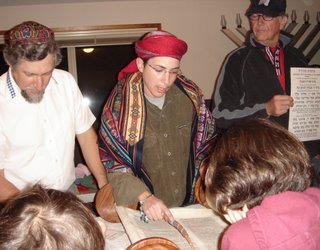
As for necessary skills, the maggid as rabbinic pastor obviously needs to mirror the basic skill sets of the rabbi and hazan, but with less emphasis on classic texts (clearly more learning is better). More midrash, less halacha. Basic working knowledge of liturgy and hazzinut, both traditional and at least one other modality (renewal/reform/carlebach, etc…) *** The ability to craft liturgy/life cycle/ and adapted ritual spontaneously and on demand—a maggidic specialty!!*** (Seriously, I do more spontaneous, in the moment teaching and ritual than I can possibly tell you. It’s a major hallmark of my experience as a maggid)
Some level of Hebrew proficiency is required—and the ability to teach it at some level. This is an absolute requirement that should not be overlooked or shortcut under any circumstances. Having said that, what level of Hebrew proficiency and what kind of teaching can vary wildly and should be approached on a case-by-case basis.
Hassidus. How anyone can be a maggid today and not be studying Hassidus, at
some level, I don’t know. Working knowledge of the Hasidic masters is a must.
Who are they, where did they live, what were the hallmarks of each one, and then of course, the teachings and texts themselves. Which teachings and which texts, I leave to you. Myself, I would require ongoing Baal Shem Tov studies supplemented by Nachman’s Likutay Moharan and as many stories about the Berdichever as possible. More is better, but this is a minimum. I highly recommend students read Buxbaum’s Bescht book cover to cover, as it is not only scholarly and well written, but in between the lines of these simple anecdotes is a textbook manual in maggidut. I’m developing an entire course for maggidim using this book, and I think people will be amazed at how much depth is hidden beneath the surface of this book’s simplicity.
If you don’t know something about Kabbalah, just the basics, you can’t be a
maggid today. Period.
Storytelling/Music/Outreach/Community Organizing, etc, etc, etc… Clearly every maggid has areas of sub specialization. I don’t think I need to explain this one to you. Again, these tools are learned as teaching mechanisms—even entertainment, dancing, and churning up a raucous smicha are teaching events… especially so! Every single person watching Daniel sing his happy song at the wedding learned something about being Jewish that day, I guarantee it. Once you get maggidut into your system, you can’t ever not be a maggid—people see this and respond to it from their very souls. I have found that there is no better teaching mechanism than being awesomely, joyously present. People tell this to me all the time, so I know it to be true. If we can do that through storytelling or music or ecstatic davening, all the better.
On a more practical level, maggidic students should have some guidance in class development; teaching strategies; dealing with boards of directors, head’s of school and maggidic-rabbinic relations. These things have to be addressed or else we are tossing people out into frontier territory to fend for themselves, which isn’t right.
Maggidic students should be fully immersed in the life of a spiritual community, be it a single shul, a minyan, or as in the case of Berkeley, with the extended Chevre. How can you learn to lead community if you’re not participating in community? This has to happen. Paired with this, of course, is the cultivation of a personal spiritual practice, including elements of mussar and taking on midot. People will look to the maggid as a living example, so we must be just that and make sure that we do things like having mezuzot on our doors, among other things, eh? This is especially true of the maggid, because many people see the maggid as being more accessible, more approachable than the rabbi. The living example of the maggid is somehow more tangible to their lives than the living example of the rabbi. This is really important. Really, really important. Again, in this way, a maggid is teaching often just by being present in the environment. So many spiritual teachers don’t grok this, and so they miss the thousand and one teaching opportunities that arise from the fact of their presence. Being present is everything.
And finally, for now, I highly recommend some amount of pastoral counseling
education. If a maggid can do a one or two year program, that’s best. But
even some workshops would help. As you know, the issues that come up in the
field around spiritual development; crisis management; grief counseling; visiting the sick; etc, etc, etc… and on and on and on—these issues are legion. To have no training whatsoever is not only going to limit the maggid’s job performance, it’s outright dangerous. I’ve seen just about everything in the last four years of working in the field, and I’m still young and new at this. People need to be prepared to encounter these things, it just has to happen by some means.
Blessings to you friend for a healthful and prosperous new year.
With love and Blessings, M'Sarah Etz Alon




